Not too long ago, the new Chelsea ownership group, led by American Todd Boehly, purchased their second professional football club, RC Strasbourg. The Ligue 1 side, who struggled last season and just survived relegation, were given a fresh start, with Boehly’s first order of business appointing former Crystal Palace and Nice manager Patrick Vieira as the club’s new head coach. Now, they have also broken their transfer record, with the French side paying just over €20 million to sign Club Brugge’s 20-year-old Ivorian centre-back Abakar Sylla.
Strasbourg are signing a defender that has only played one full season of senior football but has excelled often during his time in Belgium. This scout report and tactical analysis will take a look at the Ivorian’s style of play, as well as his strengths and where he could look to improve. This article will also examine how the defender may fit Vieira’s tactics.
Style of play and positioning overview
When it comes to Abakar Sylla’s style of play, the Ivorian centre-back is a pacey and physical defender, one that does not shy away from the ball and is strong in defensive duels. His ability in defensive duels is probably the most refined aspect of the 20-year-old defender’s game. It is undoubtedly one of the reasons Strasbourg brought him in for such a hefty transfer fee. The 20-year-old also possesses the rare combination of pace and physicality, with the defender able to beat attackers in a foot race or bully them off the ball using his 6’2″ frame.
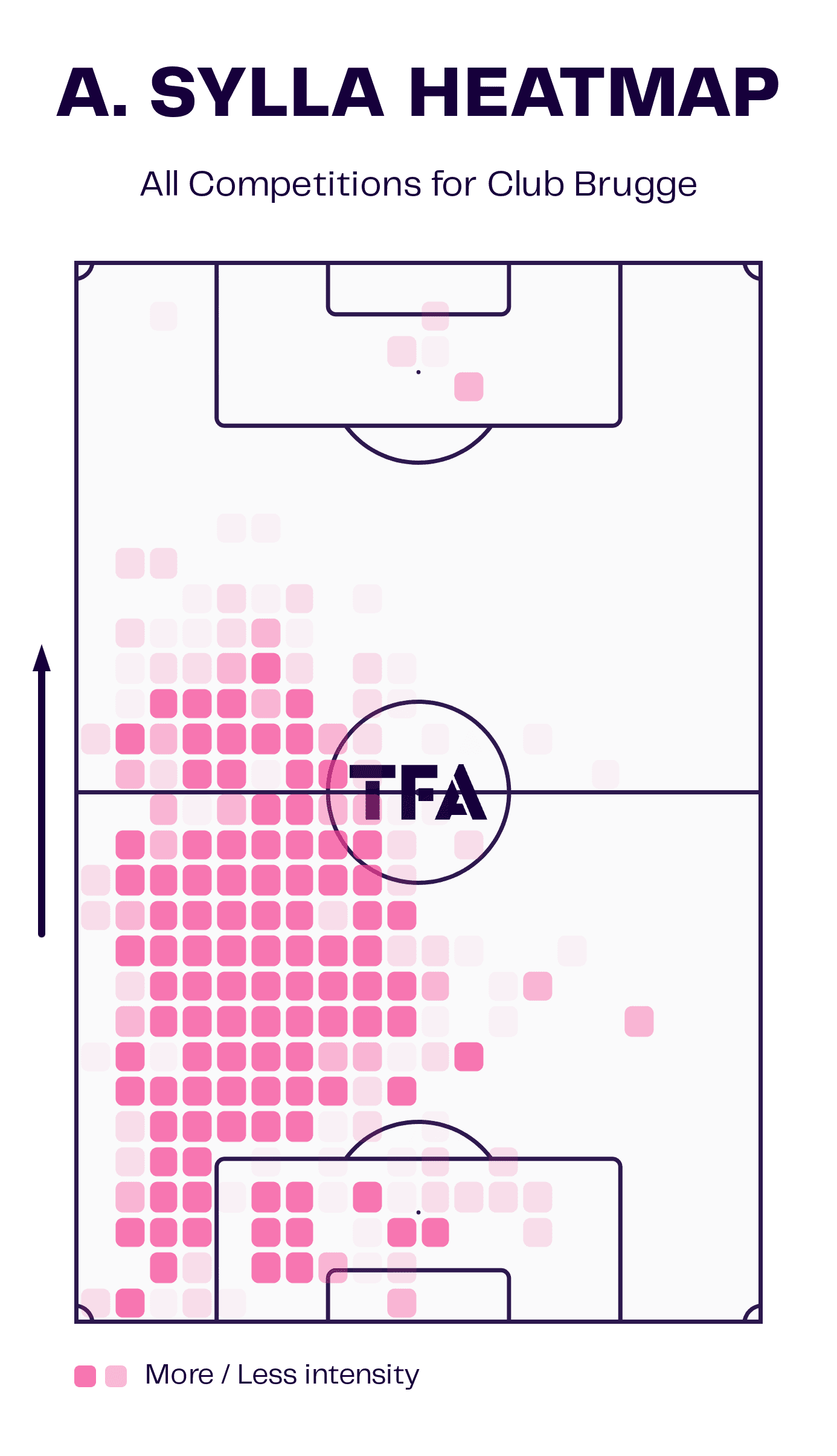
The heat map above shows the areas of the pitch where Abakar Sylla usually finds himself throughout the course of a match. As the graphic shows, most of the Ivorian’s involvement occurs on the left side of the defensive half, with the 20-year-old commonly being used as the left-sided central defender in a back-three system with Club Brugge.
As we can also see from the graphic, Sylla had the freedom to drive forward at times in the Club Brugge system, with him being heavily involved at times in the attacking half of the pitch. A lot of this comes from Sylla driving forward with the ball at his feet, with this a common trait in his game.
Under Patrick Vieira at Strasbourg, Sylla will likely encounter a back-four system, with this being the preferred system of the Frenchman at his previous managerial stops. However, Strasbourg have been a team that have often used a back three, so it is possible that Vieira could alter his system to fit the strengths of the squad he would have at his disposal.
Regardless, Sylla is likely to be an instant starter for the Alsace side, with him being an instant upgrade to the centre-backs currently in Strasbourg’s ranks.
Quality in defensive duels
As mentioned previously, Abakar Sylla excels in his quality in defensive duels. For a 20-year-old centre-back who only has essentially one year of senior experience, his quality when defending mimics that of a defender with years of experience. In fact, Sylla averages 5.39 defensive duels per 90 minutes, with a high success rate of 69.8%.
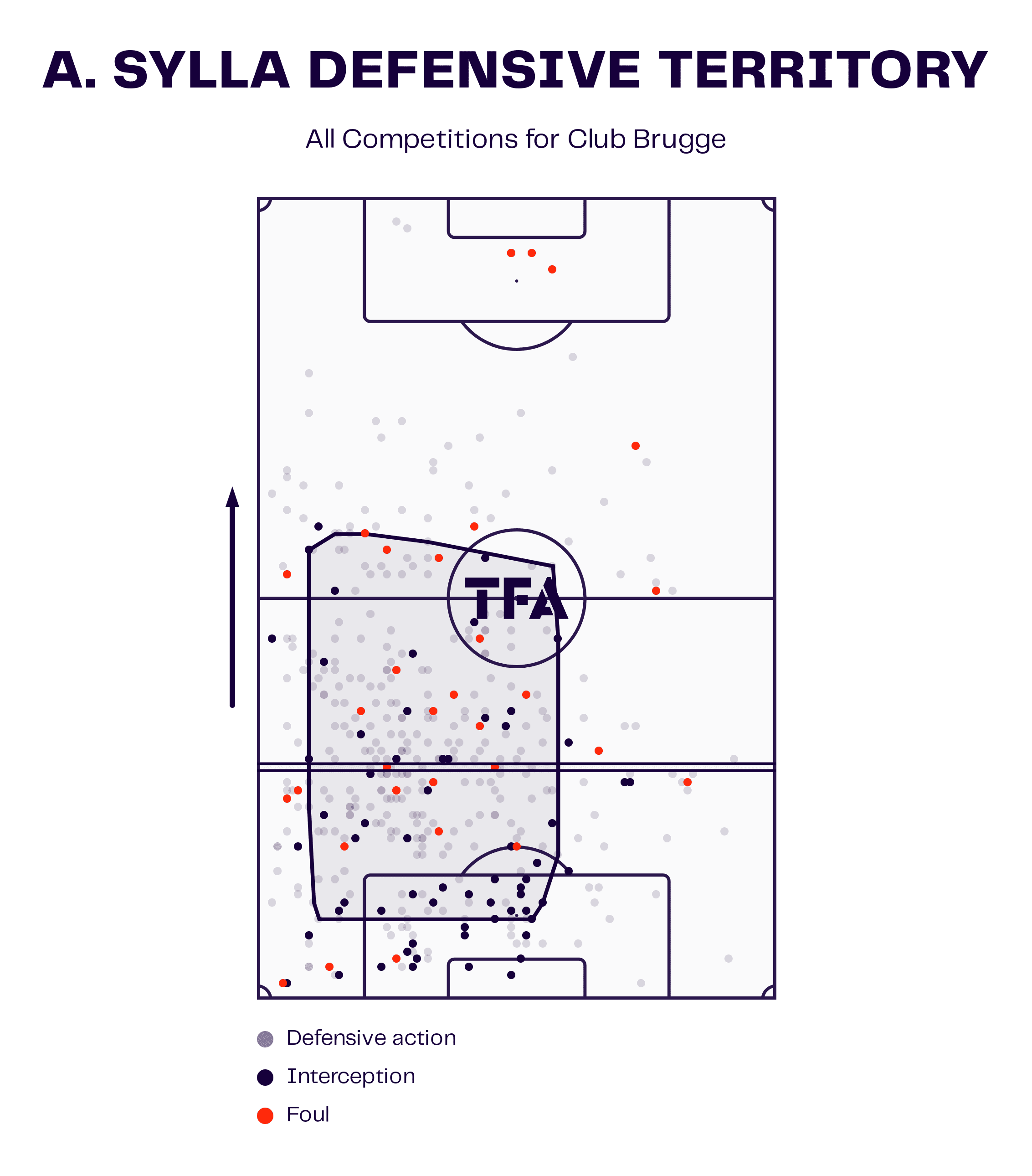
The data viz graphic above shows the defensive territory of Abakar Sylla in all competitions during his short time with Club Brugge’s first team. The Ivorian centre-back was a significant presence in the Belgian side’s backline, quickly becoming their best defender. This is illustrated by the graphic above, showing all the defensive actions, interceptions and fouls in which the 20-year-old played a part.
However, an essential thing to note is the relatively small amount of fouls the defender committed, showing his innate ability to be clean when going in for a tackle, highlighting his quality in duels for a player of such a young age and little senior experience under his belt.
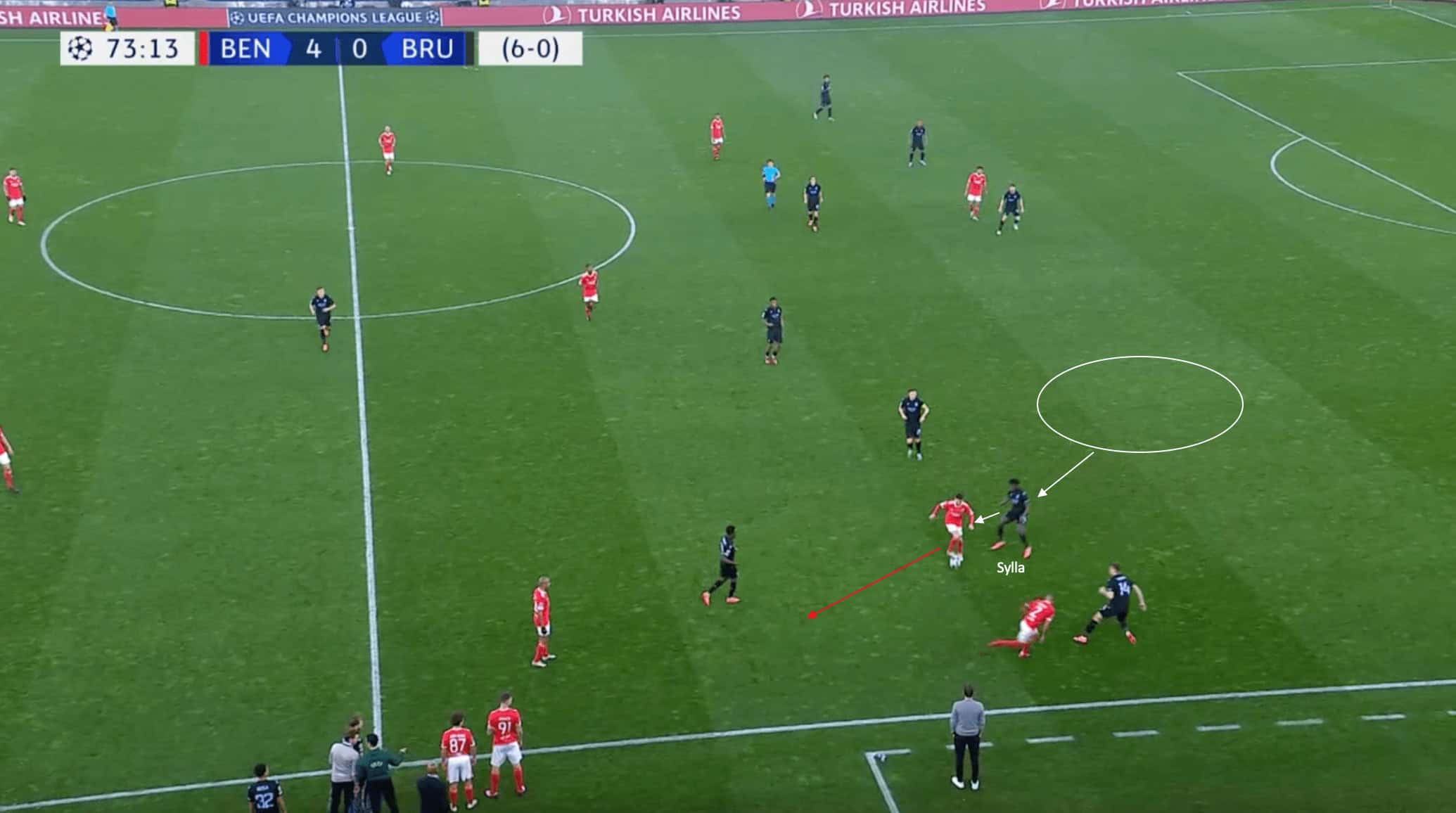
The image above shows an example of the ability in defensive duels that Abakar Sylla displays, as well as his reading of the game in defensive moments to sniff out danger. In this phase of play above from the Champions League against Benfica, the ball is in possession of the Portuguese side on the near touchline, close to the zone that Sylla is occupying. The opposition attacker tucked inside is positioned in an area where he is not marked, leaving him plenty of space to receive the ball before turning and driving towards the Club Brugge goal.
Noticing this potential danger, Sylla moves to press and close down the attacker, limiting his ability to receive the ball and turn to drive towards the goal. As a result of Sylla’s quick thinking, he pressures the attacker back towards the halfway line, with the ball going out of play for a throw-in on the near touchline.
Another quick thing to note about the 20-year-old’s decision-making here is that he was aware of the lack of danger near him of a player that could run behind him and into the space he vacated. This spatial awareness of the players around him makes him such a good defender in defensive moments like this, as it helps him to make quick decisions about when to close down opposition players in more advanced areas.
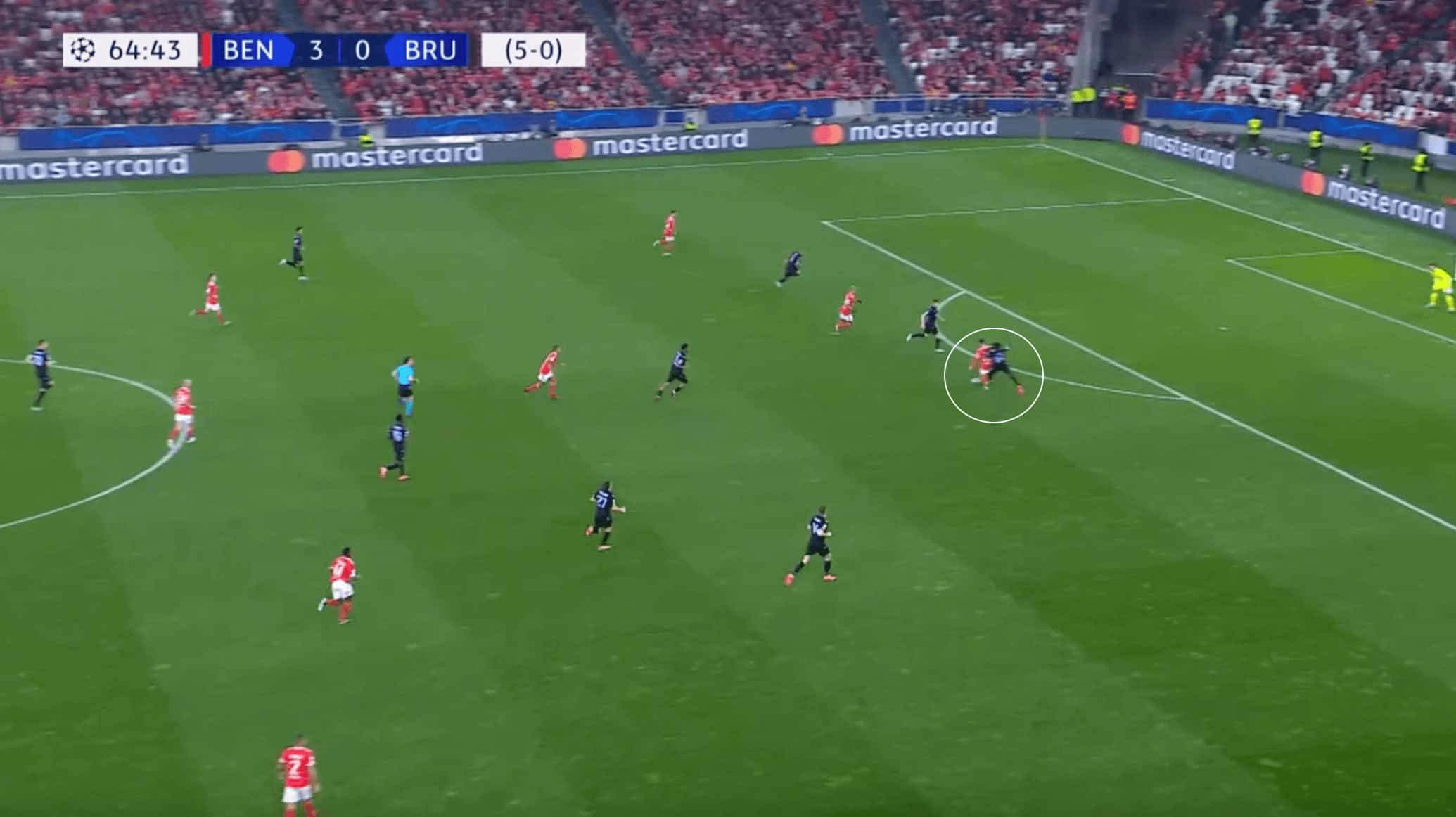
The image above shows another example of the quality in defensive duels that Sylla shows, again from the Champions League knockout tie against Benfica. This specific defensive action could actually be considered a dangerous one due to the positioning of Sylla on the wrong side of the Benfica attacker. However, this is another phase of his game where the Ivorian defender can excel really well at. First, his recovery ability in this phase was excellent, with the 20-year-old able to stay with the attacker stride-for-stride.
Then, when the deeper lying midfielder played the ball forward, Sylla was able to put a telescopic leg in the path, taking away the ball but not the man as well. This helps to illustrate the fact that Sylla is successful about 70% of the time on defensive duels. Even though he was in a poor position in relation to the ball, the Ivorian defender was still able to regain possession for Club Brugge and calmly eliminate a potentially dangerous attacking moment for the Portuguese side.
As this section has shown, Abakar Sylla has a defensive acumen that mirrors that of a defender with many more years of senior football experience than the 20-year-old has. When trying to pinpoint the strongest areas of the young defender’s game, his quality in defensive duels and ability to read the game well shine through the brightest. Strasbourg are getting one of the better young defenders in European football, with Sylla likely to get even better from a defensive standpoint as he gathers more top-flight experience.
Ability on the ball and range of passing
Another strength that this scout report will take a look at is Abakar Sylla’s range of passing and ability on the ball. Through his Club Brugge senior career in all competitions, the 20-year-old Ivorian centre-back has averaged 56.06 passes per 90 minutes, with a success rate of 89.3%. Now, this does not show the extent of the defender’s progressive passing ability, as a lot of the passes in this metric were either backward to the goalkeeper or sent to the centre-back next to him.
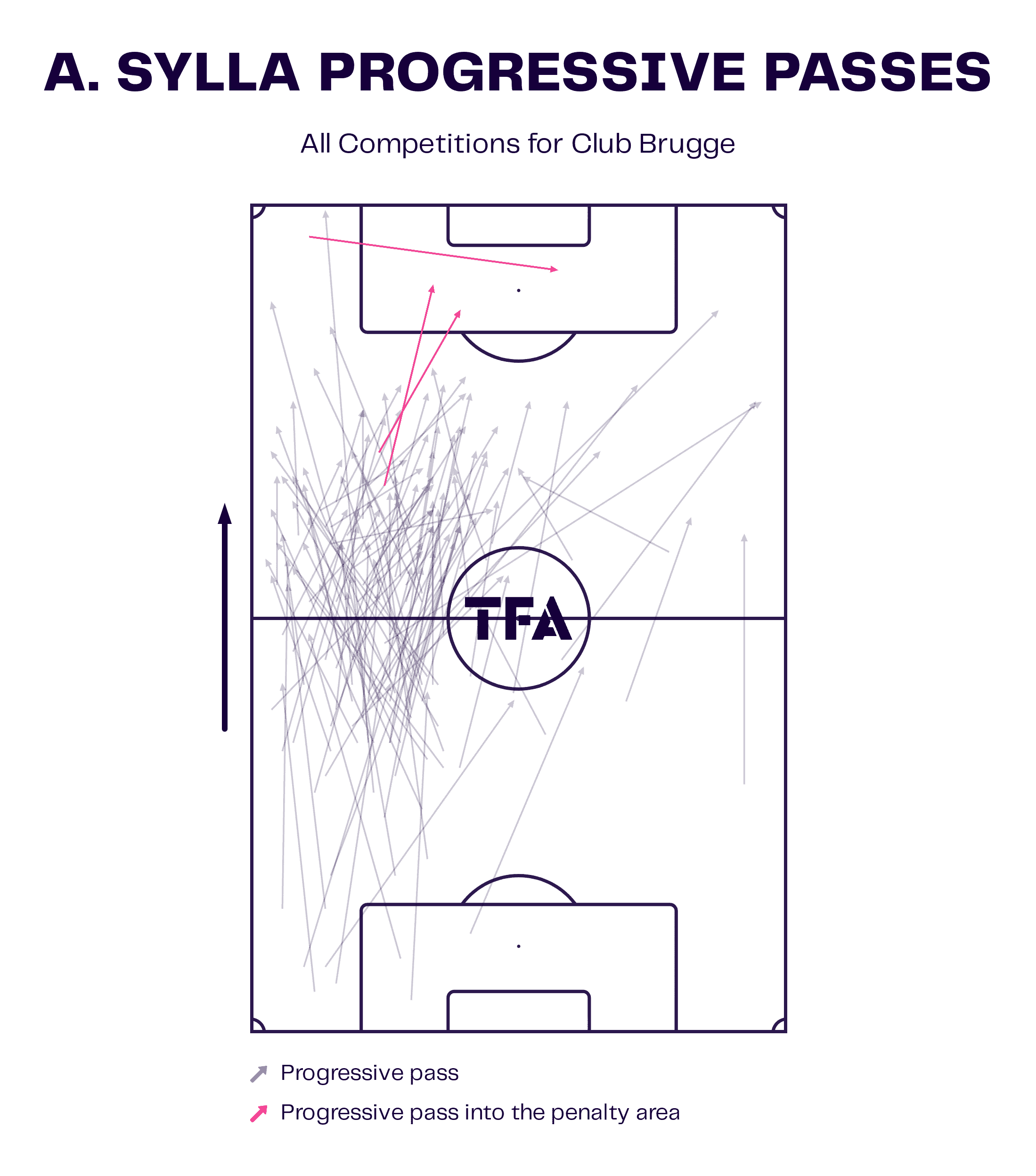
The data viz graphic above shows the progressive passes of Abakar Sylla during his time as a Club Brugge player. This highlights only the passes that Sylla played into a forward area, with the majority of them coming on the left side of the pitch. Looking deeper into the statistics, the Ivorian averages 5.09 passes to the final third per 90 minutes, with a decent success rate of 75.6%. This section will focus on Sylla’s ability to progress the ball forward through his vision on the ball and range of passing. While it still needs some refinement, it is still adequate for his senior experience.
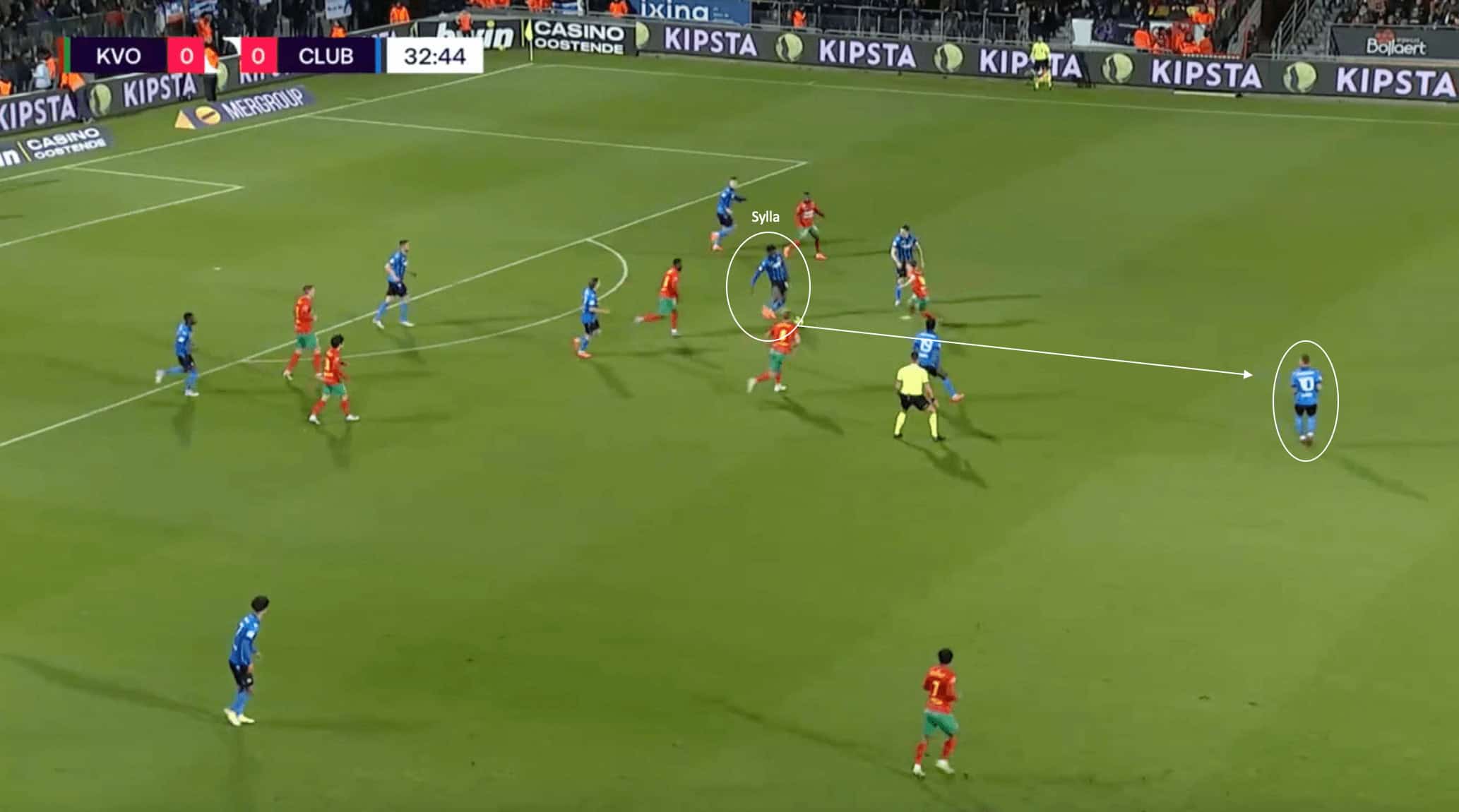
The image above shows an example of the range of passing and vision on the ball that the centre-back displays in moments. In the phase of play above against Oostende, the ball makes its way to the Ivorian, who does not have much time to make a decision on the ball, with the opposition defenders quickly closing him down. Before the defender makes his way to the loose ball, he is able to spot former Ajax player Noa Lang free behind the Oostende counter press.
In the clip, you can see the 20-year-old defender look up and spot Lang before running onto the ball, which allows him to pass the ball first time into the path of the Dutchman. As a result of Sylla’s quick decision-making, Club Brugge are able to escape their half and release on a quick counterattacking phase of play.
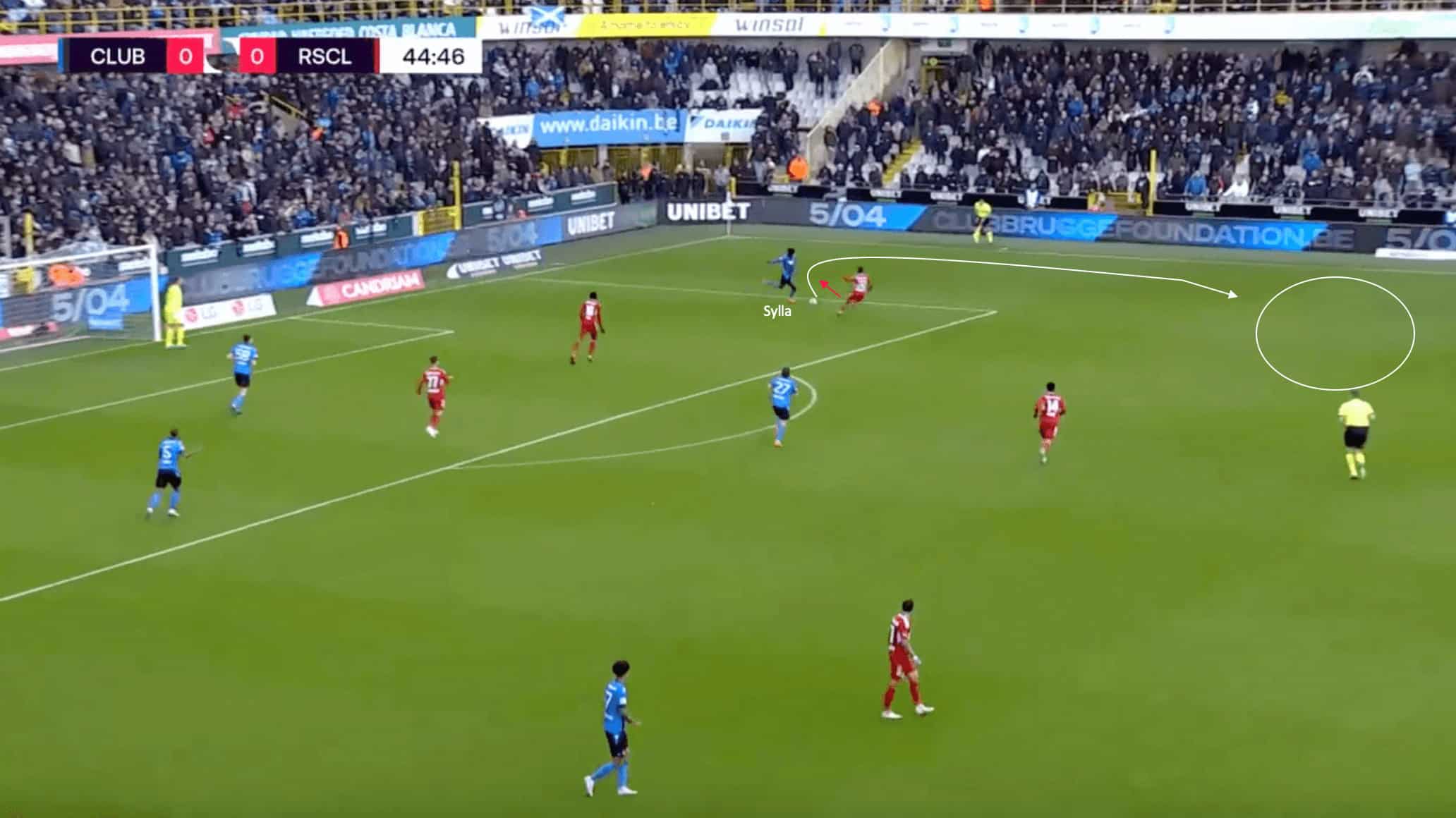
The image above shows another example of the ability under pressure that Abakar Sylla possesses in phases of play when he is in possession in his defensive half. In this specific phase from the Belgian Pro League last season, this pass under pressure actually originates from the Ivorian’s error.
After receiving the pass from the central centre-back, Sylla takes one too many touches, opening the door for the opposition forward to look and put pressure on the 20-year-old.
Even though an error forces Sylla into this predicament, he can still get himself out of it, with the Ivorian able to send a pass past the forward and into the space that a Club Brugge midfielder is dropping into to show as a passing option.
What this example shows is that there is still some work that Abakar Sylla needs regarding his decision-making on the ball at times. However, it does not take away from the fact that he still possesses quality when it comes to his capabilities with the ball at his feet.
How does Sylla compare to the other Strasbourg CBs?
When looking at the other central defender options that are currently in the Strasbourg squad, the names that stand out are 19-year-old Ismaël Doukouré, 26-year-old Gerzino Nyamsi, and 24-year-old Lucas Perrin.
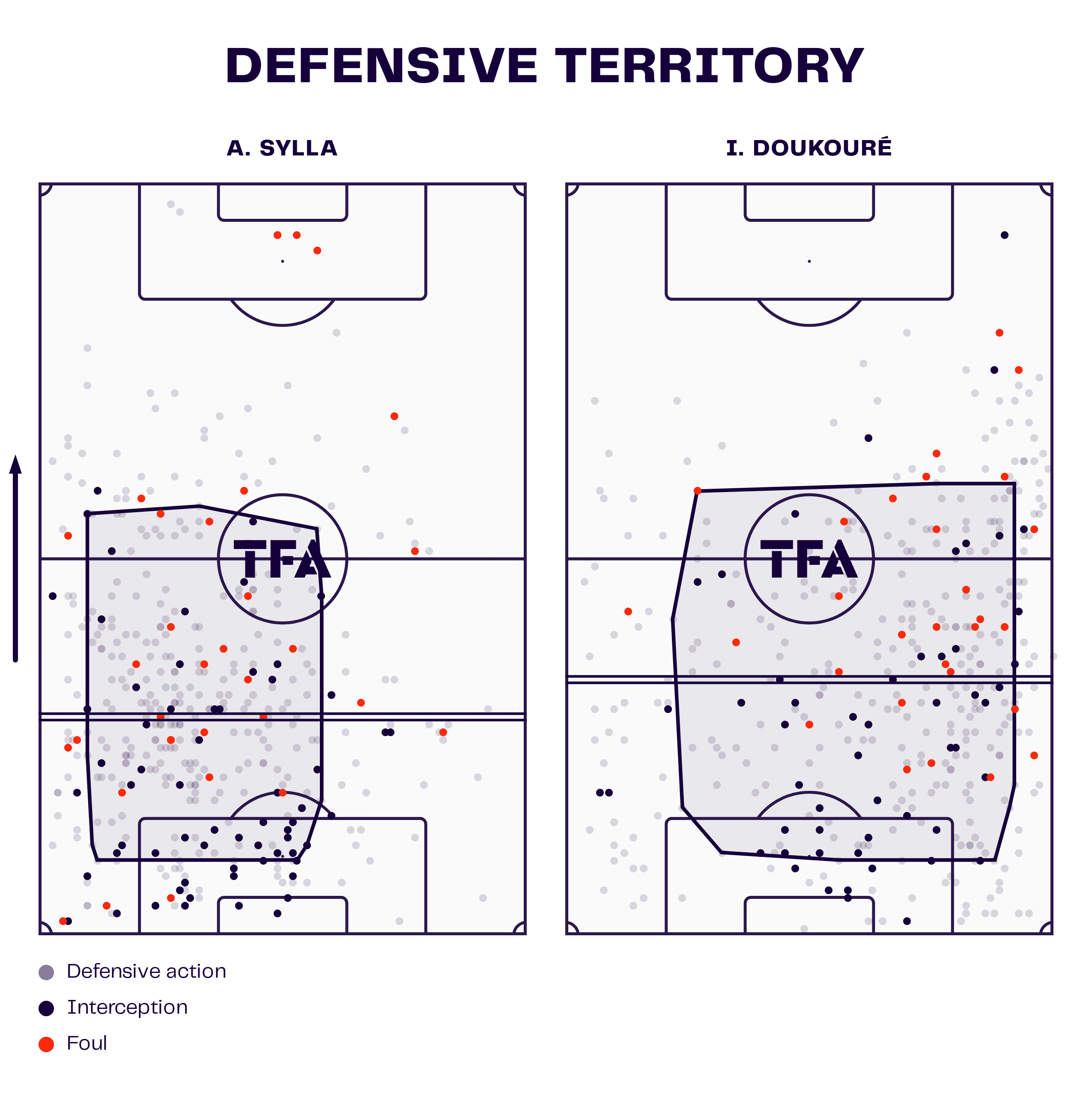
The image above shows a data viz graphic comparing Sylla to Ismaël Doukouré, Strasbourg’s other young and talented central defender. As we can see from the graphic, Sylla makes more interceptions than the young Frenchman, with this also being the case for Strasbourg’s other two central defenders that were listed. However, last season the Strasbourg three-man defence constantly rotated, with all three central defenders switching places at times during the phases of the match.
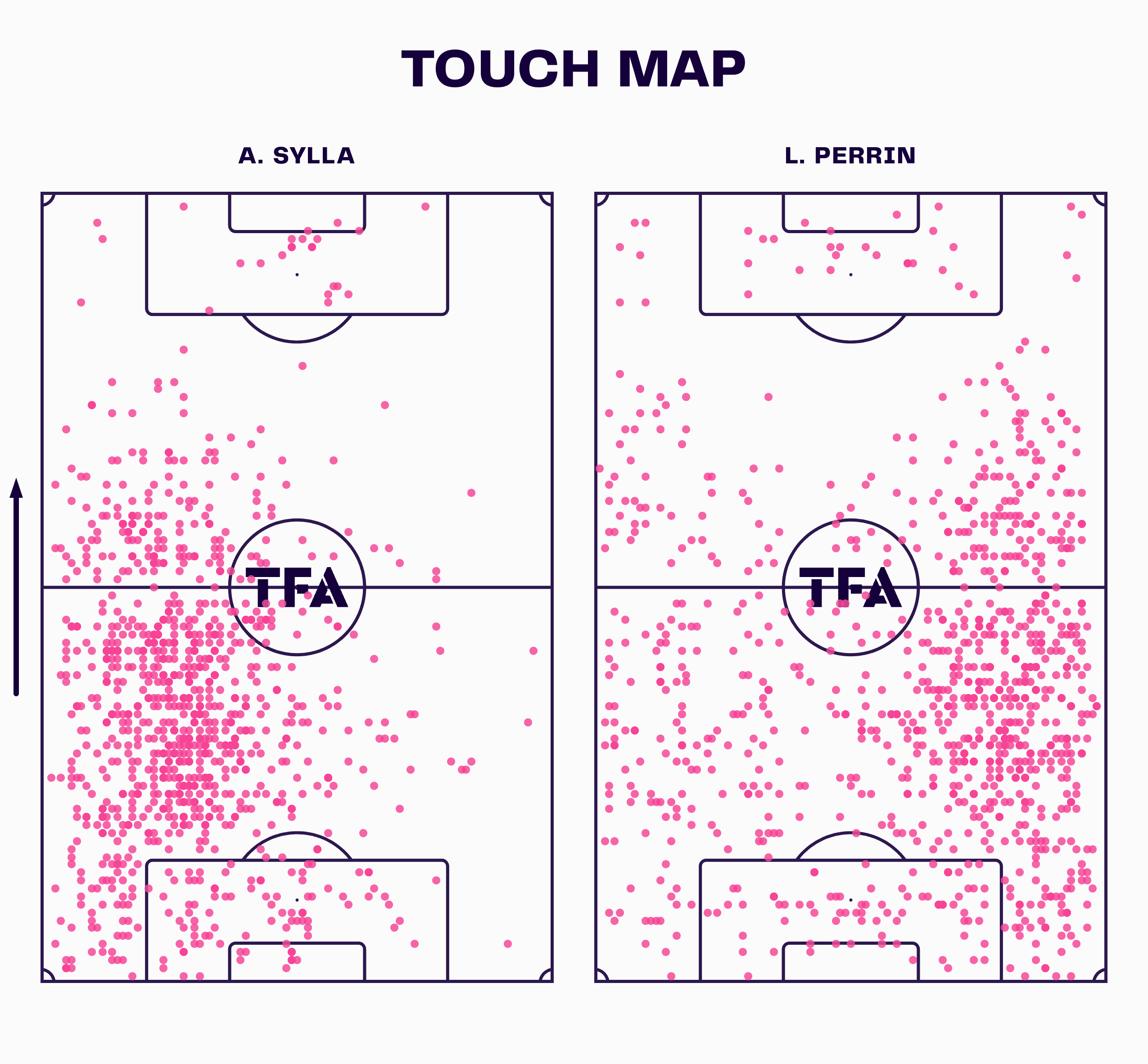
The image above shows both the touch map of Abakar Sylla and the touch map from Lucas Perrin last season. As we can see, Perrin spent most of his time on the right side of the defence but also made his way to the left at times. Whereas Sylla plays as a centre-back that is more concentrated in where he is involved on the pitch, the Strasbourg central defenders last season played more freely, as illustrated by the touch map that is shown above. This is similar to Doukouré’s, with most of the defensive actions committed by the defender on the right half of the pitch.
Looking at how Patrick Vieira likes for his sides to play, the former Arsenal midfielder opts for a possession-based system, which may be slightly hard to implement initially at Strasbourg. With the club being near the bottom of the table for the majority of last season, it is a long road back to the top for the club from Alsace, and Sylla is one of the first pieces of the puzzle for the French side.
As already mentioned earlier, Vieira will likely look to set up in a back-four system, meaning that only two of the current four central defenders will have a starting place for Strasbourg next season. Being left-footed, Abakar Sylla will likely be first choice there, with Vieira probably opting for the more experienced option next to him.
This would point to Nyamsi being the choice, but Perrin would also be likely considered. The wildcard is Doukouré, with it being possible that the Frenchman looks to develop the two most promising central defenders by playing them together. Whatever happens, Strasbourg will be an exciting team to watch in Ligue 1 next season, and Sylla will play a large part in what Vieira will look to build.
Conclusion
As this tactical analysis and scout report has shown, Abakar Sylla is one of the more promising young defenders in world football. The step up to Strasbourg is likely the best next step for him, and it would not be surprising if he makes another big jump in the very near future.





Comments